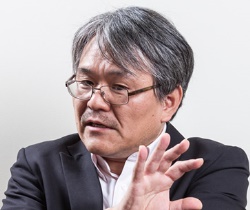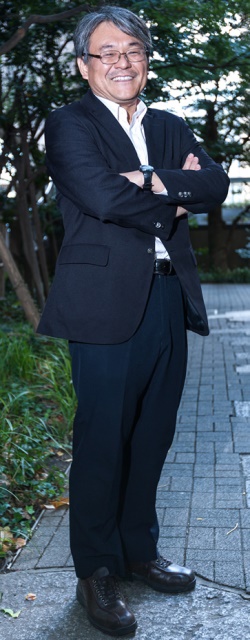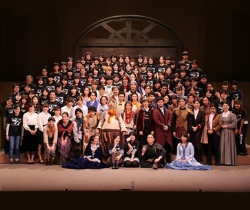Our Society is a Huge Theater

As long as we live, we constantly have to express our own thoughts through words and actions. When someone receive them, there appears a form of communication. All of those process makes a sort of chain of events that occurs when somebody receives this message, interprets it, and communicates his or her own thoughts in return, which can be described as the process by which society forms. Doesn’t it seem that this has a lot in common with the stage, another form of communication created by performers and audience? While of course it goes without saying that the actions of actors on the stage communicate each other, the same kind of interaction takes place even between performers and audience in the theatre.
The topic of my research is an examination of how Shakespeare’s dramas have been performed in various societies since the modern era. While of course Shakespeare’s dramatic works seem fixed and unchanging when seen as reading material, when performed on the stage it is inevitable that the ways of producing them and devices of theatrical expression would change in different societies and environments.
I analyze how the Shakespearean stage has changed on the massive stage of society, which can be seen also as a play within a play. This process reveals some distinct characteristics of locality and its periods.
In particular, during the 20th century, which has been called the age of the directors, Shakespeare’s plays were produced in diverse ways by a various techniques of many directors. Naturally, accepting these changes, the world of Shakespeare also expanded massively and rapidly. While of course it is a fact that improvements in stage machinery and technologies such as acoustics and lighting effects played a great role behind this development, at the same time another cause was the fact that society discovered the interest in restructuring a fixed text through applying a variety of interpretations to it. In this process we can see the unending links between the act of performance and transformations in society.
Looking at the transformations in public performances of Shakespeare also can give us a perspective on the society surrounding the stage and the relationship between society and the individual, among other matters. Through surveying these changes occurring around drama, a variety of things will come into view beyond the stage in front of us.
Viewing Society through Shakespeare

Let’s look at a few specific examples.
Participating in the resistance during World War II, the Polish-born critic Jan Kott continued to study the theatre amid various political difficulties, writing a book titled Shakespeare Our Contemporary. With his wartime experiences, Kott could no longer see the world of Shakespeare’s works as simply one of elegant tales of royalty and the nobility during the Middle Ages. To him, King Lear overlapped with the bloody spectacle of the World War and its aftermath. He could read King Lear’s tale of the struggle for the throne among various unpleasant characters only as truly reflecting his own times. This reading of Shakespeare actually had a major impact on stage practice around the 1960s, an era that has been called a season of politics. From this we can learn through drama how people’s consciousnesses changed through the war.
Let’s survey the case of Japan. In Japan, Shakespeare must be mediated by the essential process of translation. For this reason, the history of the introduction of Shakespeare to Japan since the modern era also is a history of translation. The most well known example of a prewar translation is that of Shoyo Tsubouchi, who translated the entire works by himself. He was forced to rely on the vocabulary of kabuki-like phrasing in translating Shakespeare’s texts (though he himself was seeking a contemporary form of the Japanese modern colloquial language). Of course, this could not be described as suitable for modern stage expression.
However, in the postwar years Tsuneari Fukuda, who had been shocked by the modern sense of the performances when watching Shakespearean plays in Britain, introduced this feeling in his translations, astonishing the audience and critics in Japan when he directed them himself. Perhaps this can be described as the first step of Shakespeare performances suited to the contemporary Japanese stage.
The season of politics ended in the 1970s. Yuji Odashima, with performance by young people on small stages in mind, produced adventurous, roughly colloquial translations, using easy and understandable language and appealing to the young audience. Here too one gets a strong sense of the links between society and the stage.
In the 1980s, the director Yukio Ninagawa staged Odashima’s translation of Macbeth, fully Japanized through means such as scattering cherry blossoms at the beggining of the performance and having the actors dress as samurai swordsman. Above all, this performance, considered legendary today, is highly meaningful in the way a Japanese performance of Shakespeare was recognized worldwide.
Many readers might be aware that today Japan is in the midst of an unprecedented Shakespeare boom. This is the result of efforts such as these to overcome the barriers of language and culture in a variety of ways so that the original works can be accepted in Japan.
Shakespeare Teaches Us that Human Beings are Many-Sided Creatures
Shakespeare was born in 1564, exactly 450 years ago this year. There are numerous reasons why Shakespeare, who lived more than 400 years ago, is read and performed by so many people even today.
For example, even aside from the diversity of the characters that appear in Shakespeare’s works, one of their attractions is in the way they undergo various transformations during the works. The characters change constantly in the dramatic development.
For example, the protagonist in Hamlet, who lives for revenge for his father, pretends to be mad to hide his true intention and get an opportunity for vengeance. However, his insanity act begins to conceal his true feelings, so that even he himself can no longer see the boundaries between his own feeling and his pretence. Can this kind of identity crisis be seen even in our contemporary society? We spend our everyday lives acting and hiding our own feeling. Is it not the case that we often end up losing sight of our true feelings in the process? Such a realistic description of personality appears as a character in the play. This sense of reality is what makes Shakespeare’s characters so attractive.
Even when looking at the time when Shakespeare lived, the personalities and inner states of the characters of literature and drama other than Shakespeare’s were largely stable and unchanging. But the characters Shakespeare depicts feel joy, sadness, anger, and anguish in various situations, changing constantly. Probably we could describe Shakespeare as having depicted the multi-sided nature of human beings in three dimensions and showing us the tragicomedy that arises when these people come together, just as it really is.
We tend to assume that the things we are thinking at present and the words tossed around by others represent everything about ourselves and those others. However, Shakespeare teaches us that our current psychological state will not continue forever and that even our current feelings are a synthesis of various emotions. Through Shakespeare, we can learn about human beings.
A Recommendation for Living Dramatically
Now let’s turn from Shakespeare to drama itself.
What kind of art is drama?
For example, if I were to make a gesture of fanning myself rapidly, it would convey the message that I felt hot and wanted the room temperature lowered. Since these are not words, they would not be contained in the lines of a play. However, the reason the audience understands when an actor uses this gesture in a drama to express the desire that the air-conditioning be turned on is because we have had the same experience in our everyday lives.
The same is true when in a love scene a character says “I can’t stand you” and we understand this as an expression of affection rather than hatred. In other words, dramatic expression reflects on the stage with the nonverbal grammar of human life. If we accept the meaning of “I can’t stand you” literally, then we are not appreciating the drama properly and in real life we would miss an opportunity for love. While it is said that we need to read a lot to stimulate our thinking, I would like to propose that we need to view drama, whether on stage or in a dramatic television series, if we want to enrich our humanity.
Viewing a drama is a kind of simulation of everyday life. This is because it uses the same grammar we actually use in our everyday lives. This is why we can appreciate drama, and from the opposite perspective it is why the things we have experienced unconsciously in drama can have an affect on our everyday lives.
In these and other ways, our everyday lives are dramatic, and we need to act constantly in our lives. While the term “act” may seem to imply that we are hiding our true selves, in fact we can make our lives more enjoyable if we can use this kind of acting effectively to communicate our feelings and make the most of our potential.
This is why I would encourage people to live their lives more dramatically, say, live a life theatrically, viewing various dramas and taking on a dramatic sensitivity.
Our times have been described as an age of monologue. This tendency toward monologue is strengthening further with the arrival of social media in recent years. While it is true that social media provides a variety of benefits, at the same time it also can encourage ranting. The relationships it fosters also could be described as shallow and unidirectional. On the other hand, drama is formed through dialogue between individual performers and between the performers and audience, among others. This dramatic dialogue provides opportunities to get a relative perspective on one’s own relationship to society and to reexamine oneself. In this sense, dramatic dialogue involves limitless possibilities.
Efforts Through the Shakespeare Project

I have been in charge of the University’s Shakespeare Project since four years ago. This is an attempt to have students give free public performances of Shakespeare plays in November. Incidentally, this is a part of the regular curriculum in which registered participants can earn academic credits for the fall term. This year about 120 students from various departments across campus took part. The recent performance welcomed nearly 3800 spectators. I think this reaction may show the high regard the public has for this attempt by students to take on the challenges of Shakespeare, a giant in the world of the theatre, head on and to create attractive performances reflecting their own creative efforts.
While of course it goes without saying that Shakespeare himself is an attractive presence, the success of this project is due to the way so many students—including about 80 members of theatrical staff, since the number of performers is about 40—bravely play their individual roles, both on stage and off, to create a solid performance. Without a doubt the students achieve considerable growth each year. Clearly this provides strong emotions that it would not be possible to get from being holed up in social media.
At the start of this piece I noted that society resembles a stage. Actually, society is more like a massive theatre, in which everybody plays some role while at the same time being in the audience watching others.
I definitely would like to encourage readers to become familiar with drama, so that they can perform well in this massive theater as actors and enjoy the performance as audience members. I also would like to encourage them to take part in the Shakespeare Project as well!
http://www.kisc.meiji.ac.jp/~bunpro/
* The information contained herein is current as of November 2014.
* The contents of articles on M’s Opinion are based on the personal ideas and opinions of the author and do not indicate the official opinion of Meiji University.
Information noted in the articles and videos, such as positions and affiliations, are current at the time of production.


